Coffee Genetics and Variety Selection

This post is also available in:
This post is also available in:
![]() हिन्दी (Hindi)
हिन्दी (Hindi) ![]() Português (Portuguese (Brazil))
Português (Portuguese (Brazil))
How many coffee species exist – Which are the most popular coffee varieties
In the past article, we briefly mentioned some factors (such as altitude and temperature) that need to be considered when planting coffee. Still, perhaps one aspect that shouldn’t be forgotten is the genetic one. As with everything in nature, coffee trees come in quite a wide variety. They belong to the Coffea genus in the Rubiaceae family of flowering plants. More than 100 species are known, and they have developed with changes in height, shape, fruit color, and flavor, as well as bean productivity. As the Coffea plants naturally spread through the different African regions and climates, their adaptability also changed; in recent times, this adaptability has also been further explored as different countries and coffee associations have created hybrids to boost productivity and increase resistance to diseases such as coffee rust. Therefore understanding these varieties is essential before deciding which species best suits your needs and plantation.

Image created by the author using as references El gran libro del café By Anette Moldvaer p.14, and Café Imports Genealogical tree: www.cafeimports.com
Of the four Coffea species shown in the above image, around 60% of the coffee produced worldwide is Arabica, while 40% is Robusta[2]. Coffee Development Report by the International Coffee Organization (ICO), p.68, states that Arabica beans had a global share of 59.2 % of coffee production during the 2021-22 season. Just within these two, there are different varieties, partly thanks to natural evolution and partly thanks to new crosses and hybrids that humans have created. This is not to say that Liberica and Excelsa are not for human consumption, but they are not commonly found and grown only for local consumption in the countries that do have them; with time, agronomists and coffee growers have begun experimenting with them and discovering new species and varieties.
Once roasted, both Arabica and Robusta have distinct flavors, fragrance (when dry), and aroma (once it comes into contact with boiling water), so they are both grown for different purposes.
This series of articles is intended to serve as an introduction and lay the groundwork for cultivating Coffea Arabica. Still, before diving deep into its cultivation guidelines, we’ll explore more of its differences with Robusta to understand its purposes and added value.
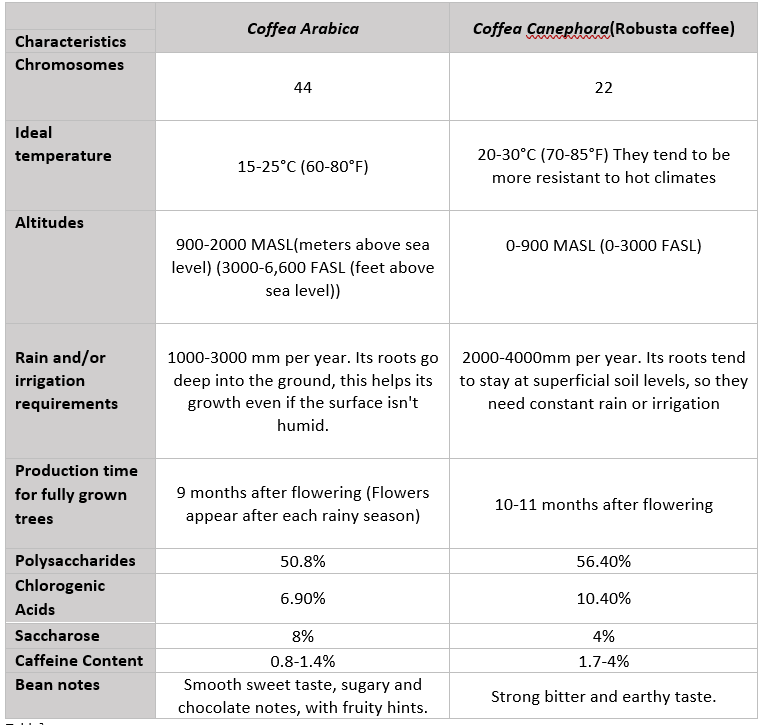
Table[3]
Arabica tends to be used for Specialty Coffee by traders, roasters, and consumers looking for an excellent cup flavor. In Contrast, Robusta beans are quite harsh, so they can withstand the required process for making decaffeinated and instant coffee. In addition, roasters take advantage of its caffeine strength to make blends with grinded Arabica beans to make different drinks such as Espresso and Cold Brew.
Brazil and Vietnam are the main Robusta producers, however as a geographical region, it is Asia where most of the Canephora exports come from, while Latin American countries tend to be the region with the most production of Arabica beans; in this region, Colombia, and once again, Brazil are the main producers in quantity.

Arabica Coffee Varieties
Moving forward, we’ll try to explore some of the different varieties within the Arabica species. In this guide, we’ll try to cover as many as possible; however, it’s important to note that my expertise comes from my farming practice in Latin America. Different varieties might be more popular or better suited for other regions.
Traditional varieties:

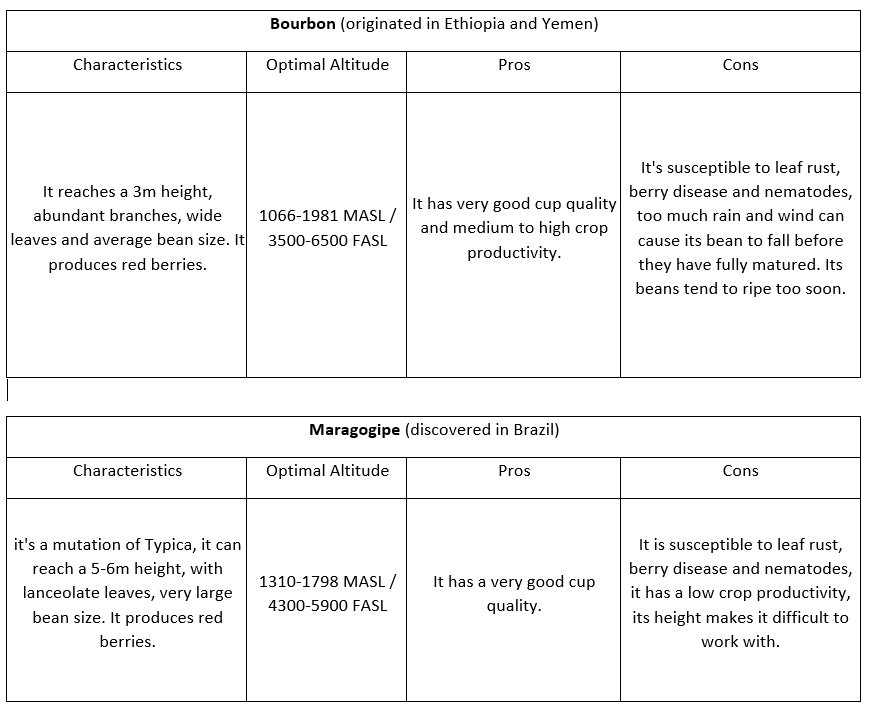
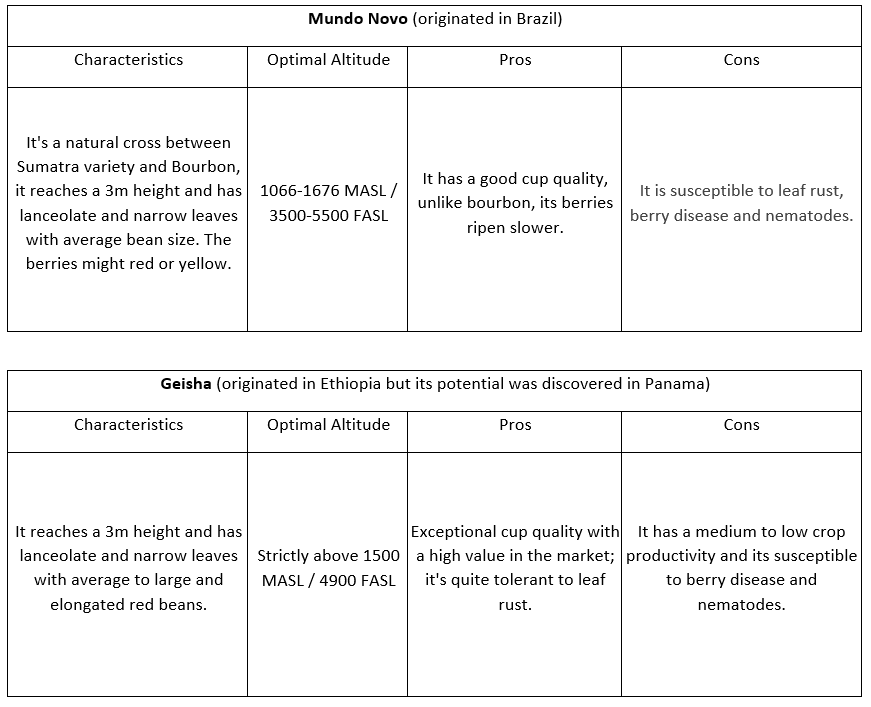
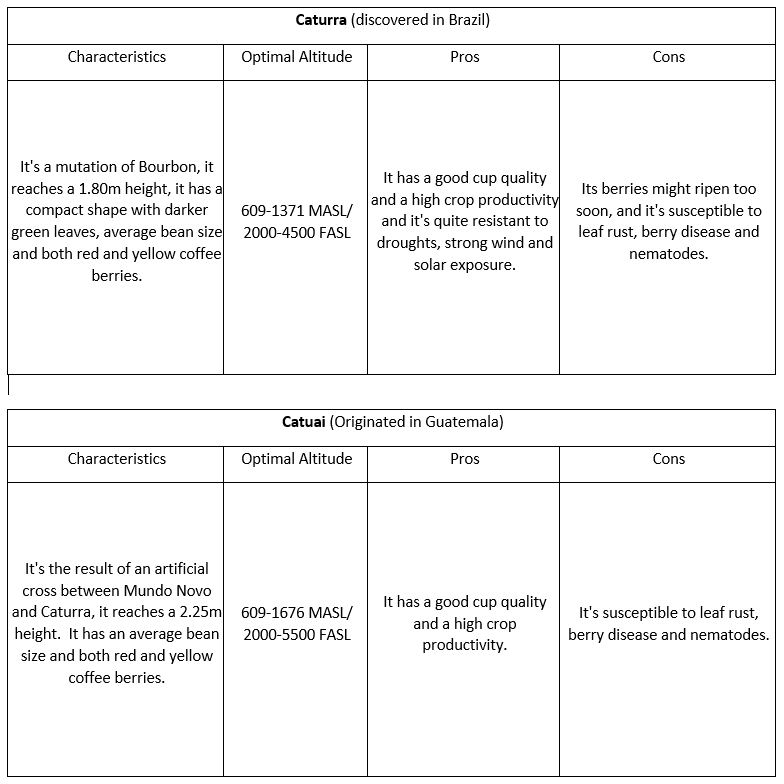
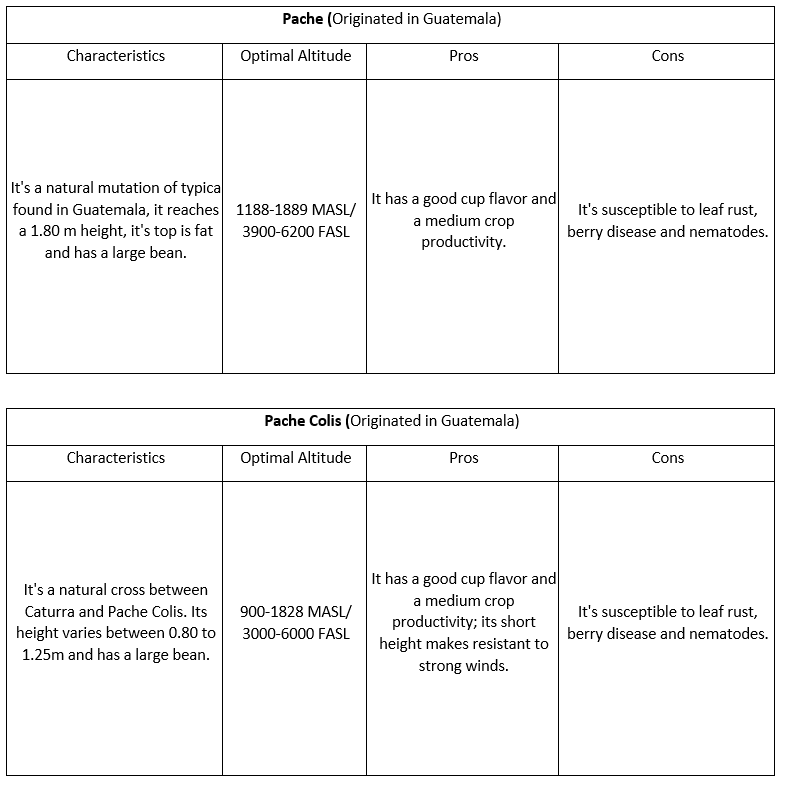

The above varieties have been traditionally grown throughout different countries. With the exceptions of the PacheColis and Catuai varieties mentioned in the above tables, most of these trees came into existence naturally and through mutations and spontaneous crosses with other varieties. In recent years, farmers have faced new difficulties, such as lack of rain (drought) and hotter seasons, that have come as a direct consequence of climate change. At the same time, this has become a factor that has ravaged several plantations. Warm climates create ideal conditions for the spread of diseases like Coffee Leaf Rust.
In addition, the world coffee market is growing exponentially, so the need for a higher yield is constantly in the coffee grower’s mind.
This has increased the need to find and create varieties of Coffea capable of withstanding the conditions of the modern era. Luckily one variety that has opened a window for this experimentation is the Timor Hybrid, which was discovered in East Timor in 1917. This hybrid appeared through a spontaneous cross of C. Robusta and C. Arabica’s Typica, which is uncommon since both are different species with different chromosome numbers.
In simple words, it could be said that the Timor Variety has the best of both worlds, Arabica’s bean quality and Canephora’s natural resistance to several diseases such as Leaf Rust. Nowadays, it has played an important role in breeding new varieties.
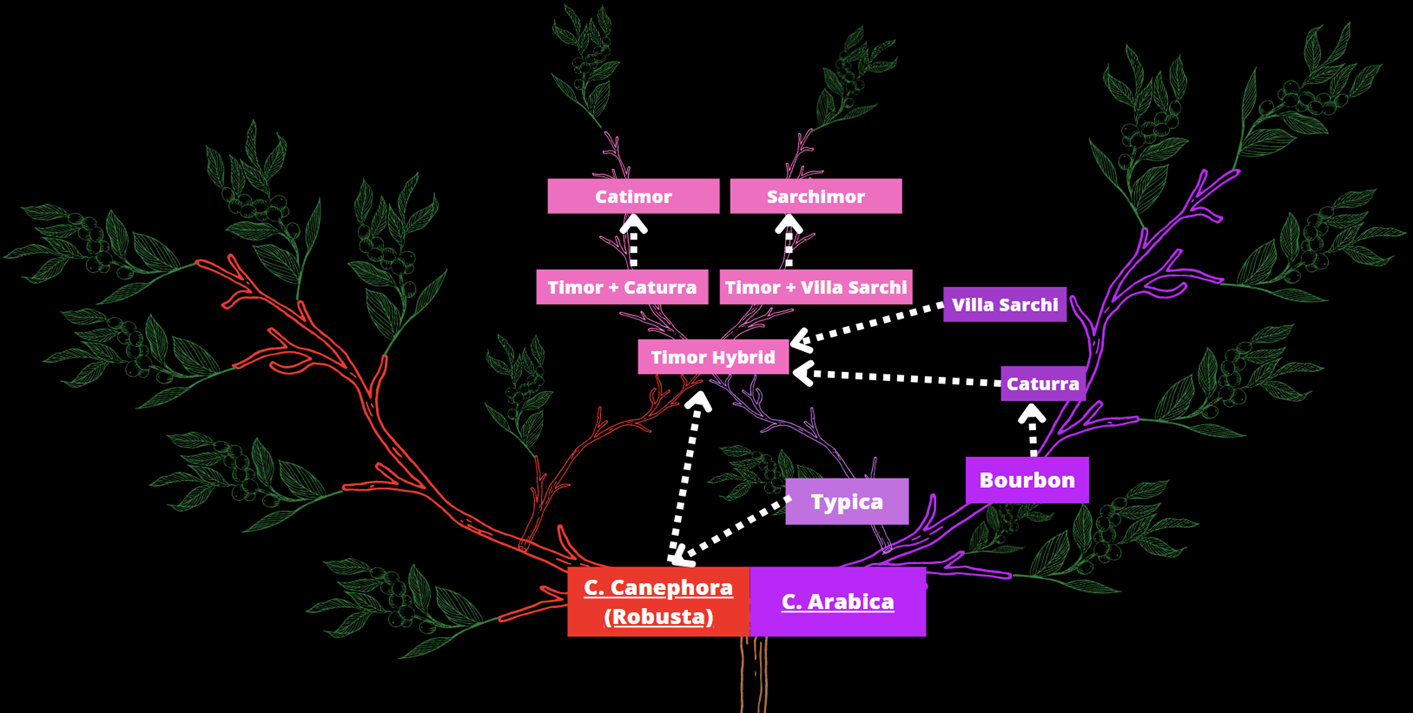
This image was created by the author using Guía Técnica de caficultura(Coffee growing technical guide) 2018, Asociación Nacional de del Café (Anacafé), Guatemala, P.35
As we can see in the above image, Bourbon’s Villa Sarchi and Caturra were used to create Catimor and Sarchimor, which also have their own descendants:

As we adapt to the changing times, more varieties will come into existence; there are even more than the ones I have mentioned in this article. However, it is essential to note that this is a slow process requiring much care and attention. When a new variation comes naturally into existence, first, it must be discovered, this cannot be done with a simple glance from a plantation with thousands of trees, and genetic testing must be done to conclude that we have a new type of Coffea.
When it comes to artificially creating new breeds, things do not get any easier. This process requires a selection process of 5 to 6 generations of seeds and plants, taking up to 35 years of research.
Without a doubt, before deciding what type of coffee tree you want to plant; you must thoroughly think about what you want to do with your final product, as well as, understand your situation, needs and farm requirements in order to know what variety to choose from.
In my case, I am a 3rd generation coffee grower, and the circumstances under which I started administrating my plantation where completely different to the ones my grandparents had when they started planting coffee trees in Guatemala back in the 1940’s. Until 2013, my farm had mainly grown traditional Coffea varieties such as Bourbon, Caturra and some early forms of Catimor; there was never a real need to experiment with a different variety. Between the years of 2005 and 2015 the Coffee Leaf Rust disease destroyed coffee plantations all the way from Brazil to southern Mexico causing losses in the millions of dollars and hectares. This disease was previously known, but climate change and warmer weathers allowed these fungi to spread more effectively in recent times. At present, 85% of my farm has been cultivated with two relatively new varieties, Ancafé 90 (Catimor-5175) and Anacafé 14 (Cross of Catimor-5175 with Pacamara). Although not immune, these varieties have proven to be quite resistant to the rust attack. The first challenge I faced was the one of making my land a productive unit once more. Both new types of Catimor have proven to be quite strong and also productive. Now that production is back on track, I can start to consider other factors, such as cup quality, in order to decide what variety might be a good option for planting the remaining 20% of my land.
It is also important to seek an expert’s advice. Practically every country that grows this amazing crop has a national coffee association that has been created to perform and offer the necessary research and resources for farmers. At the same time, this guarantees that the best quality coffee will be exported and sent to the final consumers.
These associations constantly collaborate internationally with each other and can be contacted for specific inquiries. Their websites also have articles and published papers that always come in handy for any farmer who wants to start growing coffee or improve its agronomical practices. So, before finishing, I would like to share a list of these associations.
References
- El Salvador: Salvadorean Coffee Council ConsejoSalvadoreño del Café (csc.gob.sv
- Guatemala: National Coffee Association (Anacafé) Asociación Nacional del Café (anacafe.org)
- Honduras: Honduran Coffee Institute (IHCAFE) IHCAFE – Instituto Hondureño del Cafe – Instituto Hondureño del Cafe
- Costa Rica: Coffee Institute of Costa Rica (ICAFE) ICAFE – Instituto del Café de Costa Rica
- Colombia: National Coffee Research Center Cenicafé – FNC Colombia Página Principal | www.cenicafe.org
- Nicaragua: National Alliance of Nicaraguan Coffee Growers ANCN
- Mexico: Mexican Coffees Cafés de México – informaciónprofesional de los CAFÉS DE MÉXICO y del Mundo (cafesdemexico.com)
- Brazil: Brazilian Coffee Exporters Council (CECAFE) Home – Cecafé (cecafe.com.br)
- Hawaii, USA: Hawaii Coffee Association Hawaii Coffee Association – Home
- South East Asian Nations (ASEAN): ASEAN Coffee Institute & ASEAN Coffee Federation Home – Asean Coffee
- World Wide: Coffee Quality Institute (CQI)
- Annette Moldvaer, El gran libro del café, First Edition 2015, Grupo Editorial Pinguin Random House, p. 14, 15 & 19.
- Revista El Cafetalero, Centro Nacional de Investigaciones de Café (CENICAFE) Colombia, December 2012, Issue 414, P. 2-3. RevistaElCafetaleropresenta: ComposiciónQuímica De Una Taza De Cafe porCenicafe. by El Cafetalero – Issuu
- International Coffee Organization (ICO), Coffee Development Report (2021). The Future of Coffee – Investing in youth for a resilient and sustainable coffee sector. 0dd08e_b2c2768ae87045e383962ce14ef44925.pdf (internationalcoffeecouncil.com)
Coffee Variety tables are taken from:
-Guía Técnica de caficultura 2018, Asociación Nacional de del Café (Anacafé), Guatemala, P-27-45
-World Coffee Research Arabica Catalog Arabica Coffee Varieties | Variety Catalog (worldcoffeeresearch.org)
[1] Image created by the author using as references El gran libro del café By Anette Moldvaer p.14, and Café Imports Genealogical tree: www.cafeimports.com
[2] Coffee Development Report by the International Coffee Organization (ICO), p.68, states that Arabica beans had a global share of 59.2 % of coffee production during the 2021-22 season.
[3] Anette Moldvaer, El gran libro del Café, p,19 / Revista El Cafetalero, Centro Nacional de Investigaciones de Café (CENICAFE) Colombia, December 2012, Issue 414, P. 2-3
[4] This image was created by the author using Guía Técnica de caficultura(Coffee growing technical guide) 2018, Asociación Nacional de del Café (Anacafé), Guatemala, P.35
Coffee Plant Information – Morphology
Coffee Genetics and Variety Selection
How to Select, and Treat Coffee Seeds
Germination of Coffee Seeds and Creation of Seedbeds for Planting
Coffee Trees Planting and Plant Spacing
How to Prune your Coffee Trees in an Agroforestry System
Shade-Grown Coffee in an Agroforestry System
Coffee Tree Flowering and Pollination
From Rainwater Harvesting to Irrigation of Coffee Trees
Coffee Tree Fertilization Requirements
Weed Management in a Coffee Plantation








































































